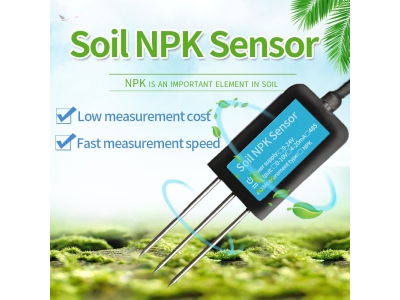Sustainable agriculture is becoming increasingly important as we face global challenges such as climate change, population growth, and resource scarcity. To address these challenges, innovative technologies are being developed to improve farming practices and optimize resource management. One such technology that holds great promise is soil sensor technology. Soil sensors allow farmers to gather real-time data on soil conditions, enabling them to make informed decisions and maximize crop yields while minimizing environmental impacts. In this article, we will explore the applications of soil sensors in sustainable agriculture and their potential to revolutionize modern farming practices.
Monitoring Soil Moisture:
Water scarcity is a significant concern in many agricultural regions, making efficient water management critical for sustainable farming. Soil sensors provide valuable insights into soil moisture levels, allowing farmers to optimize irrigation practices. By monitoring soil moisture in real-time, farmers can determine when and how much water to apply, ensuring that crops receive adequate hydration while minimizing water wastage. This precision irrigation not only conserves water but also promotes healthier plant growth and reduces the risk of waterlogging or nutrient leaching.

Precision Nutrient Management:
Proper nutrient management is essential for healthy plant growth and optimal crop yields. Soil sensors enable farmers to monitor nutrient levels in the soil, ensuring that crops receive the right amount of fertilizers. By measuring nutrient concentrations, farmers can adjust fertilizer applications accordingly, avoiding over-fertilization which can lead to environmental pollution and under-fertilization which can result in reduced yields. This precision nutrient management improves resource efficiency, reduces costs, and minimizes the environmental impact of agricultural practices.
pH Monitoring and Soil Health:
Soil pH plays a crucial role in determining nutrient availability and overall soil health. Soil sensors can measure pH levels in real-time, providing farmers with valuable information about the acidity or alkalinity of their soil. This data allows farmers to make informed decisions regarding soil amendments and adjust pH levels as necessary. Maintaining the optimal pH range promotes nutrient uptake by plants, improves soil structure, and encourages beneficial microbial activity. By monitoring pH levels, farmers can ensure that their soil is healthy and conducive to maximum crop productivity.
Detecting Soil Compaction:
Soil compaction can have a detrimental impact on crop growth, root development, and water infiltration. Soil sensors can help detect compaction by measuring soil density or resistance. Farmers can use this information to identify areas of compacted soil and take appropriate measures to alleviate compaction. By addressing soil compaction issues promptly, farmers can optimize root development, improve water drainage, and enhance overall soil quality. This leads to healthier crops and increased yields.
Managing Soil Salinity:
Excessive soil salinity can be a significant challenge for farmers, particularly in arid or semi-arid regions. Soil sensors can measure soil salinity levels, helping farmers monitor and manage this issue effectively. By identifying areas with high salinity, farmers can adjust irrigation practices, implement leaching techniques, or choose salt-tolerant crop varieties. This targeted management approach reduces the negative impacts of salinity on crop growth and ensures sustainable productivity in affected areas.
Early Pest and Disease Detection:
Early detection of pests and diseases is crucial for effective management and prevention of crop losses. Soil sensors can provide valuable insights into pest and disease dynamics by monitoring soil conditions. Changes in soil moisture, temperature, or other key parameters can indicate the presence of pests or diseases. By integrating soil sensor data with pest and disease models, farmers can receive early warning signs and take proactive measures to protect their crops. This early detection leads to more targeted and sustainable pest and disease management strategies.
Integrated Decision-Making:
The true power of soil sensors lies in their ability to integrate with other technologies and data sources, enabling holistic decision-making. By combining soil sensor data with weather forecasts, satellite imagery, or crop models, farmers can gain a comprehensive understanding of their fields' conditions. This integrated approach allows for precise resource allocation, optimizes planting schedules, predicts yield potential, and minimizes risks associated with weather events or market fluctuations. By making data-driven decisions, farmers can improve efficiency, reduce waste, and maximize profitability.
Conclusion:
Soil sensor technology has the potential to unlock new possibilities for sustainable agriculture by prov






